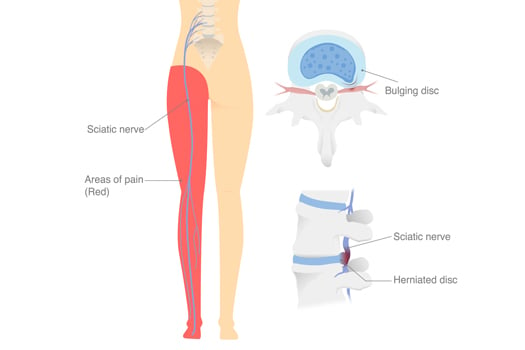
A common reason to have microdiscectomy surgery is to relieve pressure on the sciatic nerve, which begins at the base of the spine. Since this is the single longest nerve in the human body, it can take a while for it to fully heal after surgery and relieve nerve irritation and pressure. This article discusses how long it typically takes for the sciatic nerve to fully heal after having a microdiscectomy.
You May Experience Initial Relief
It is not uncommon for microdiscectomy patients to notice relatively immediate relief following surgery. However, there will likely still be some discomfort during the initial microdiscectomy recovery period. Part of this discomfort comes from the process of tissue healing, but some of it comes from lingering nerve-related discomfort.
You May Have Lingering Nerve-Based Pain
It is not always easy to tell the difference between normal post-surgery discomfort and lingering nerve-based pain. Indications that any lingering discomfort you are experiencing may be related to the sciatic nerve include:
• Numbness and tingling sensations
• Muscle weakness within the affected area
• Pain or discomfort that extends down into your thighs, hips, buttocks, or legs
Sciatic Nerve-Based Pain May Last a Bit Longer than Post-Surgery Pain
Your post-surgery discomfort should typically subside after about 4–6 weeks, especially after you begin your physical therapy program. However, you may still notice some of the nerve-based symptoms mentioned above beyond this point. As for how far beyond the 4–6 week point the discomfort will lessen, the answer depends on factors such as:
• How long the sciatic nerve was compressed prior to your surgery
• The extent of the pressure the herniated disc placed on the nerve
• How much you participate in physical therapy to strengthen the muscles around the sciatic nerve
Your general health prior to surgery is an important factor as well. Underlying health issues that affect circulation, such as diabetes, could contribute to inflammation. This, in turn, could affect the sciatic nerve where it was once compressed by the spinal disc material.
Your Doctor Can Help You Deal with Post-Microdiscectomy Sciatic Nerve Pain
The sciatic nerve sometimes takes a bit longer to fully heal after a microdiscectomy because the nerve can still send phantom impulses or signals. This can happen due to the way the sciatic nerve was compressed as well as the other factors mentioned above.
As for how to effectively deal with this type of post-surgery discomfort, the first step is to talk to your doctor or surgeon. This way, you can get an accurate diagnosis to determine if the issue is normal sciatic nerve healing or something else. In rare instances, the affected disc may herniate again, which is referred to as reherniation. If the issue is just normal post-surgery nerve healing, treatment recommendations may include:
• Anti-inflammatory medications
• Therapeutic exercises or stretches
• Hot and cold therapy applied directly to the affected area for about 15–20 minutes at a time
If you have a herniated disc that is not responding to conservative treatment, a microdiscectomy may be discussed and potentially recommended. Although this is generally a very successful procedure, having a large hole in the outer ring of the disc more than doubles the risk of needing another operation. A new treatment, Barricaid, is a bone-anchored device that closes this hole, and 95 percent of Barricaid patients did not undergo a reoperation due to reherniation in a 2-year study timeframe. This treatment is done immediately following the discectomy—during the same operation—and does not require any additional incisions or time in the hospital.
If you have any questions about the Barricaid treatment, ask your doctor or contact us at 844-288-7474.
For full benefit/risk information, please visit: https://www.barricaid.com/instructions.


Comments